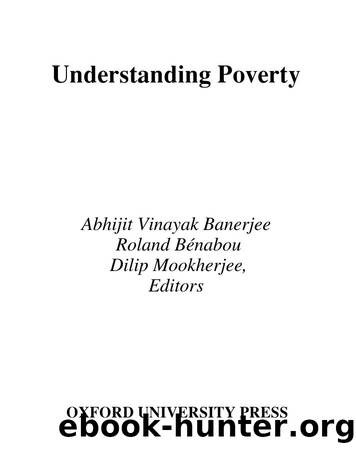Understanding Poverty by unknow

Author:unknow
Language: eng
Format: epub
Published: 2006-05-27T13:34:45+00:00
15
Poverty Persistence and Design of
Antipoverty Policies
Dilip Mookherjee
The experience of teaching the section on poverty in a public economics or development economics course is usually quite a letdown. After admitting the great importance of the topic, the typical course starts by devoting a substantial amount of discussion to different ways of measuring poverty. This is followed by a review of statistical estimates of poverty. Finally some policy issues are discussed: the scope and coverage of safety nets, whether transfers should be cash or in-kind, targeting and problems of work disincentives.
This reflects not just the typical textbook treatment but also most existing research on poverty by economists. 1 Conspicuous by its absence is a coherent analysis of what causes poverty in the first place, its implications for the functioning of the economy, and the persistence of poverty into the future.
The key questions seem never to be posed. What are the mechanisms by which people get trapped in chronic, long-term poverty? What kinds of policies might affect the nature of dynamics in and out of poverty? The discussions of measurement and policy seem to operate in a theoretical vacuum, with no emphasis on understanding mechanisms of causation. They tend to take as given the current distribution of assets and capabilities and figure out how to measure the extent of deprivation (in terms of consumption or income outcomes) and how to relieve it in the short run, ignoring possible implications for the future evolution of poverty.
Whatever little analytical content there is, concerns discussions of work disincentive effects and targeting in the design of antipoverty policies. The underlying analytical framework is a Mirrlees (1971) optimal income tax model. Each agent in the economy is characterized by a given income earning capability, and selects a work effort. The government can monitor only 231
232
How Should We Go About Fighting Poverty?
achieved incomes, which depend on the conjunction of ability and effort.
Low-ability individuals would hardly be able to earn any income despite the application of effort, and thus fall into poverty (defined by some income threshold). An antipoverty policy would provide income support for these households, financed by taxes on higher-ability households. By their very nature, the benefits provided must be phased out as household incomes rise and cross the threshold, thereby creating a work disincentive. The more comprehensive the coverage at the bottom end, the higher the taxes needed and the steeper the benefit phaseout must be, weakening incentives of the poor to raise their incomes and escape poverty on their own. This is the fundamental trade-off, the resolution of which depends on labor supply elasticity, the distribution of abilities, and societal inequality aversion. Mirrleesâs own calculations, based on British data, suggested that a substantial part of the population may be induced not to work at all in the optimal policy, even with relatively low inequality aversion.
Whatever support is provided to the poor, this framework suggests, should be in the form of cash rather than in-kind transfers because cost-effective design of an antipoverty policy entails raising the utilities of the poor as far as possible at given fiscal cost.
Download
This site does not store any files on its server. We only index and link to content provided by other sites. Please contact the content providers to delete copyright contents if any and email us, we'll remove relevant links or contents immediately.
| Administration | Assessment |
| Educational Psychology | Experimental Methods |
| History | Language Experience Approach |
| Philosophy & Social Aspects | Reform & Policy |
| Research |
The Art of Coaching Workbook by Elena Aguilar(48335)
Trainspotting by Irvine Welsh(20082)
Twilight of the Idols With the Antichrist and Ecce Homo by Friedrich Nietzsche(17720)
Fangirl by Rainbow Rowell(7843)
Periodization Training for Sports by Tudor Bompa(7341)
Change Your Questions, Change Your Life by Marilee Adams(6654)
This Is How You Lose Her by Junot Diaz(5798)
Grit by Angela Duckworth(4746)
Red Sparrow by Jason Matthews(4683)
Asking the Right Questions: A Guide to Critical Thinking by M. Neil Browne & Stuart M. Keeley(4599)
Paper Towns by Green John(4177)
Room 212 by Kate Stewart(4113)
Ken Follett - World without end by Ken Follett(3981)
The Sports Rules Book by Human Kinetics(3597)
Housekeeping by Marilynne Robinson(3419)
The Motorcycle Diaries by Ernesto Che Guevara(3344)
Introduction to Kinesiology by Shirl J. Hoffman(3305)
Exercise Technique Manual for Resistance Training by National Strength & Conditioning Association(3298)
Double Down (Diary of a Wimpy Kid Book 11) by Jeff Kinney(3284)
